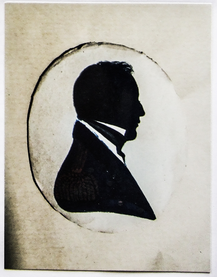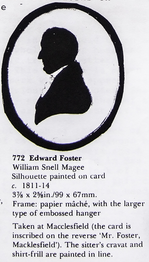Foster, Edward (SCC Newsletter November 2000)
Edward FOSTER 1762-1864 fl. 1811 - 1838.
HIS ‘BLACK’ SILHOETTES.
The mention of Edward Foster's name conjures up those works in venetian red with gilded highlights signed under the bust-line "Foster pinxt" & dated. Many of us are less familiar with his black faced silhouettes - either painted entirely in black or painted with gold, greenish or greyish coloured clothing. In this article I am going to look at those black faced works.
Firstly, some biographical detail on Mr. Foster. He came from a family with a tradition of longevity - he lived to be nearly 103! He spent much of his life in Derbyshire and was known as "Foster of Derby". He served in the army from 1780-1805 - was commissioned in the 20th. Foot and saw service abroad and fought at the Battle of Alexandria in 1801. It is likely that he painted whilst in the army. After leaving the army he lived in Windsor from 1805-1810, where it is possible that he was drawing master to Princess Amelia until her death. There are references to him being a miniature painter by royal appointment - but there are no known works by him of the Royal Family, although he did use the royal crown on his hangers by 1817!
He started his silhouette career in 1810 - he travelled about the country visiting London, Liverpool, Maclesfied, Suffolk, Plymouth & Totnes. In 1832 he settled back in Derbysire. He was a prolific artist in spite of his late start at 43 - his clients were numerous and some distinguished such as Lord Byron & Sir Walter Scott. He married five times and had seventeen children - only the youngest survived him and he was ninety when she was born! He said on his 100th birthday that “he had never known what sickness meant". In spite of his sucess he had financial difficulties at the end of his life and was buried in a pauper's grave.
Demond Coke the author of "Confessions of an Incurable Collector" is always worth reading on a silhouette artist. He described Foster as "the very post impressionist of silhouettists" - he considered that he had not been given his due place amongst the greater profilists. He saw him as an innovator of whom not everyone approved.
Mrs. McKechnie in her Book did a great deal of research on his background and has a long entry on him in Section 2 (pages 400-405). He is mentioned in all Sections except that dealing with artists who cut their work. He advertised work on plaster & glass but none can be attributed to him. His work on ivory is known. Two water-colour portraits by him are owned by the V. & A. Museum. As mentioned he may have painted soldiers whilst in the army - showing careful details of uniform similar to John Buncombe. He was clearly a painter of some skill and ability and it is perhaps strange in some ways that he decided to concentrate on silhouettes as a means of earning his living.
The silhouette on the right is illustrated in Mrs. Mckechnie's Book on page 476. The detail in gum arabic can not be shown clearly, but this covers the whole of the head and shows details of her dress. It should be possible (just!) to see the chinese white. Note the bust-line termination. The hanger details I will describe later in this article.
E. Foster's black work cont’d.
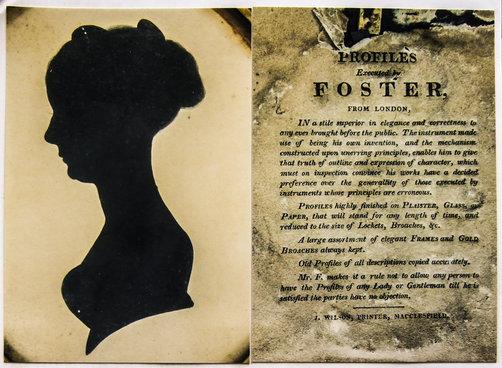
Illustrated above is a silhouette of a young woman larger than life-size painted entirely in black. Her actual size from the top of her head to the front peak of her bust-line termination is 2½". It is just possible to see details of her hair & clothing, which has been highlighted with the use of gum arabic mixed with thinned pigment - this covers her head & her dress and shows her ear & necklace. It is difficult to see the detail head-on - but seen in a favourable light it is skillfully and well done. She has a long up sweeping eyelash, which is a feature of Foster's work. Her bust-line termination is much the same as the lady on the previous page with a sharper point at the front end. As I will show there is some variation in Foster's bust-line terminations, but all are recognisable as Foster's work. On the right above is her label - this is illustrated in Mrs. McKechnie on page 478 illus. 787 and the text is fully quoted on page 404. I am grateful to the collector for letting me photograph this silhouette & label.
The illustration on the right together with her details is from Mrs. McKechnie's Book - it is similar to the lady on the previous page.
E. Foster's black work cont’d.
Illustrated on the right is a silhouette from the Andrews Collection at Stoner House - it is of Henry Rilton of Sole Street. It has no label or signature, but it has the smaller type of embossed hanger on the frame. It is clearly by Mr. Foster. The photograph was taken some years ago - so is not of the best, but I think shows enough detail to be useful. Again gum arabic has been used all over the head for detail - there are also wide lines of gum arabic on his jacket. His shirt front is painted in thinned pigment. He has a good eyelash. He has a typical male bust-line termination - much flatter than those on the ladies but still with a peak at the front. Also on this page is the silhouette of a naval officer - which was sold as a Foster. I think it may be by him as it has some of the characteristics of his work. Gum arabic shows details of hair and the bust-line termination is right. However, I think he has been 'doctored' a little as there are tell-tale signs of blue paint on his white collar as you will see. His eyelash appears to have been tampered with. I illustrate it for what it is worth!
The two other works illustrated below are from Mrs. McKechnie's Book. I think both illustrate Foster's black work well. The young boy is in the costume section of the Book. It is of an unknown boy and there are no details of label or hanger. He is on page 176. Mr. Magee has full details and is illustrated on page 475. Looking at all this page you see the slight variation in their bust-lines.
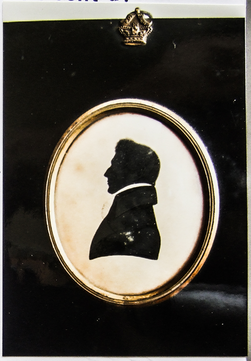
E. Foster's black work cont’d.
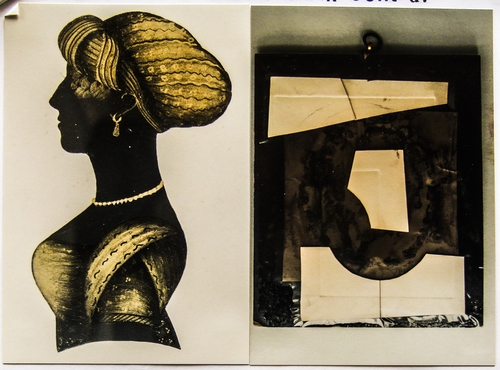
Illustrated above is a very stylish young woman wearing a turban. She has been photographed larger than life-size - she is actually 2¼” from the top of her head to the bottom of her bust-line. All details of her clothing is painted in fine gold brush strokes. Gum arabic covers the whole of her head and clothing. Foster's characteristic trefoil pattern is shown very clearly on her dress. This pattern is often regarded as Mr. Foster's trade mark when it appears - as good as a signature for attribution purposes. She has a distinctive bust-line - not unlike that of the black lady on page 2 of this article except for her sharper point at the back.
On her right is a photograph of the back of her frame showing the pieces of card that were found by me when I opened up her frame some years ago. A similar group of card pieces are illustrated in Mrs. McKechnie on page 479 illus. 794. Sometimes a lock of hair has been found with the pieces, but not in this case! The pieces are from the card that Mr. Foster used for his work and were perhaps used for packing as an economy! The frame in which the lady is housed is large - i.e. 6¼" x 7¾" and it has a small embossed Foster hanger. The lady photocopied on the right is again from the Book and is on page 476. She has the trefoil pattern.
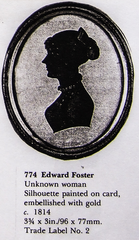
E. Foster's black work cont’d.
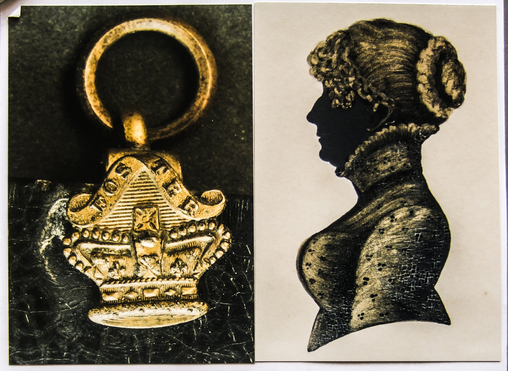
Illustrated on this page is another lady photographed larger than life-size to show detail of her hair & clothing. She is in similar 'mould' to the turbanned lady on the previous page, but in her case you can clearly see the crazing of her gum arabic - particularily just above the right hand side of her bust-line termination. As most of us know this is one of the problems with gum arabic. Fortunately in many cases it stays in place in spite of the crazing. This lady is housed in a frame with the smaller embossed Foster hanger. I have photgraphed this hanger on her left - again greatly enlarged to show detail.
Foster produced two sizes of embossed hanger. Oddly the smaller hangers were used on the larger frames - these varied in size. Usually these were 7¼" X 5¾", but could be as large as 7¾" X 6¼". The smaller frames which had the bigger hangers varied in size from 5¾" X 4¾" to 6" X 5". Mrs. McKechnie states that the frames were used until 1816 and the smaller frames to 1825 or later. So the type of frame helps to date Foster's work. The later Venetian red works by Mr. Foster rarely have a Foster hanger and are usually housed in standard papier mache frames with a variety of hangers. On the right is another illustration from Mrs. McKechnie - she is on page 148 in the costume section. There are no details about her frame - but she has the trefoil pattern dress and a black face!
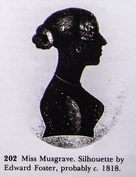
FOSTER 'S BLACK WORK Cont'd.
Illustrated on this page is an enlarged image of a lady with a more unusual bust-line termination. She was sold to her present owner as probably being by Mr. Foster - I think there is no doubt that she is. Her photograph has come out particularly well - so it is possible to see the gum arabic on her hair, which in this case has been combined with thinned chinese white. It is also possibly to see the gum Arabic on her dress, which is slightly crazed. Chinese white has been used to paint her necklace & earrings. She has the sweeping eyelash, which is present on all the other examples I have used in this article. She is very smartly presented. Her bust-line termination is very similar to an illustration in Mrs. McKechnie on page 148, which I have photocopied above. This lady is in evening dress - perhaps Mr. Foster felt this bust-line suited a lower-cut dress! I have photocopied a print of an engraving of Mr. Foster in his 100th year - it may not come out very well.
Foster was a skilled painter and used fine brush strokes for his work. His black silhouettes are attractive in my view - particularly the ladies with their golden trefoil patterned dresses. Arthur Mayne in his book compared his gilding to that of John Field - I cannot agree with this but agree that he is an underrated artist.


